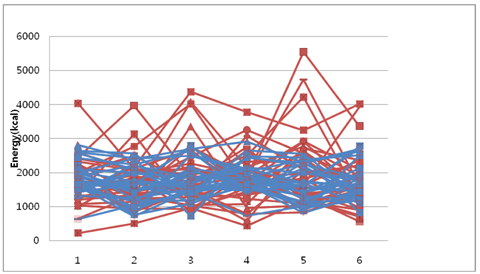Nutr Res Pract.
2010 Oct;4(5):433-437.
Dietary patterns of obese high school girls: snack consumption and energy intake
- Affiliations
-
- 1Department of Food and Nutrition, Keimyung University, Sindang-dong, Dalseo-gu, Daegu 704-701, Korea. jsook@kmu.ac.kr
Abstract
- In order to develop an obesity management program for teenagers, we compared obese and non-obese girls attending high schools in terms of their dietary practices related to snack consumption. Dietary records were collected for 7 days. No significant differences were found for the average daily energy intake between obese and non-obese girls. However, the highest energy intake was greater for obese girls while not much difference was found for the lowest amount of energy intake. Obese girls had significantly lower intakes in calcium (P < 0.01), vitamin A (P < 0.001) and folate (P < 0.01). Mean energy intake from snack (594.1 +/- 312.1kcal) was significantly higher for obese girls than for non-obese girls (360.1 +/- 173.1kcal) (P < 0.001). A significant, positive correlation was observed between energy intake from snack and total daily energy intake (r = 0.34 P < 0.01) only for obese girls. In case of dietary behaviors, obese adolescent girls consumed significantly greater number of items for snacks and fewer foods for regular meals compared to non-obese girls (P < 0.05). This study suggested that obesity management programs for adolescents should focus on providing strategies to reduce snack through enhancing balanced regular meals.
Keyword
MeSH Terms
Figure
Reference
-
1. Ogden CL, Flegal KM, Carroll MD, Johnson CL. Prevalence and trends in overweight among US children and adolescents 1999-2000. JAMA. 2002. 288:1728–1732.
Article2. Kang YJ. The prevalence of childhood and adolescent obesity over the last 18 years in Seoul Area. The Korean Journal of Nutrition. 1997. 30:832–839.3. Park J, Hilmers DC, Mendoza JA, Stuff JE, Liu Y, Nicklas TA. Prevalence of metabolic syndrome and obesity in adolescents aged 12 to 19 years: comparison between the United States and Korea. Journal of Korean Medical Science. 2010. 25:75–82.
Article4. Ministry of Health and Welfare. Report on 2005 National health and nutritional survey. 2006. Seoul:5. Bezerra IN, Sichieri R. Eating out of home and obesity: a Brazilian nationwide survey. Public Health Nutr. 2009. 12:2037–2043.
Article6. Bowman SA, Vinyard BT. Fast food consumption of U.S. Adults: impact on energy and nutrient intakes and overweight status. J Am Coll Nutr. 2004. 23:163–168.
Article7. Nicklas TA, Yang SJ, Baranowski T, Zakeri I, Berenson G. Eating patterns and obesity in children. The Bogalusa Heart Study. Am J Prev Med. 2003. 25:9–16.8. Carlson A, Gerrior S. Food source makes a difference in diet quality. J Nutr Educ Behav. 2006. 38:238–243.
Article9. Townsend MS, Aaron GJ, Monsivais P, Keim NL, Drewnowski A. Less-energy-dense diets of low-income women in California are associated with higher energy-adjusted diet costs. Am J Clin Nutr. 2009. 89:1220–1226.
Article10. Ministry of Health and Welfare. In-depth analysis on the 3rd (2005) Korea Health and Nutrition Examination Survey-Nutrition Survey. 2006. Seoul:11. Shemilt I, Harvey I, Shepstone L, Swift L, Reading R, Mugford M, Belderson P, Norris N, Thoburn J, Robinson J. A National evaluation of school breakfast clubs: evidence from a cluster randomized controlled trial and an observational analysis. Child Care Health Dev. 2004. 30:413–427.
Article12. Lee MS, Sung JS, Sung MK, Choi MK, Lee YS, Cho KO. A comparative study on food habits and nutrient intakes among high school students with different obesity indexes residing in Seoul and Kyunggi-do. Korean Journal of Community Nutrition. 2000. 5:141–151.13. Park JA, Yoon JS. Dietary behaviors and status of nutrient intakes by the obesity levels of housewives in Daegu. Korean Journal of Community Nutrition. 2005. 10:623–632.14. The Korean Nutrition Society. Dietary Reference Intakes for Koreans. 2005.15. Bandini LG, Schoeller DA, Cyr HN, Dietz WH. Validity of reported energy intake in obese and nonobese adolescents. Am J Clin Nutr. 1990. 52:421–425.
Article16. Champagne CM, Baker NB, DeLany JP, Harsha DW, Bray GA. Assessment of energy intake underreporting by doubly labeled water and observations on reported nutrient intakes in children. J Am Diet Assoc. 1998. 98:426–433.
Article17. Singh R, Martin BR, Hickey Y, Teegarden D, Campbell WW, Craig BA, Schoeller DA, Kerr DA, Weaver CM. Comparison of self-reported, measured, metabolizable energy intake with total energy expenditure in overweight teens. Am J Clin Nutr. 2009. 89:1744–1750.
Article18. Drummond S, Crombie N, Kirk T. A critique of the effects of snacking on body weight status. Eur J Clin Nutr. 1996. 50:779–783.19. Woo J, Cheung B, Ho S, Sham A, Lam TH. Influence of dietary pattern on the development of overweight in a Chinese population. Eur J Clin Nutr. 2008. 62:480–487.
Article20. Kelishadi R, Pour MH, Sarraf-Zadegan N, Sadry GH, Ansari R, Alikhassy H, Bashardoust N. Obesity and associated modifiable environmental factors in Iranian adolescents: Isfahan Healthy Heart Program-Heart Health Promotion from Childhood. Pediatr Int. 2003. 45:435–442.
Article21. Kerr MA, Rennie KL, McCaffrey TA, Wallace JM, Hannon-Fletcher MP, Livingstone MB. Snacking patterns among adolescents: a comparison of type, frequency and portion size between Britain in 1997 and Northern Ireland in 2005. Br J Nutr. 2009. 101:122–131.
Article22. Viskaal-van Dongen M, Kok FJ, de Graaf C. Effects of snack consumption for 8 weeks on energy intake and body weight. Int J Obes (Lond). 2010. 34:319–326.
Article23. de Graaf C. Effects of snacks on energy intake: an evolutionary perspective. Appetite. 2006. 47:18–23.
Article
- Full Text Links
- Actions
-
Cited
- CITED
-
- Close
- Share
- Similar articles
-
- Influence of stress on snack consumption in middle school girls
- Energy intake and snack choice by the meal patterns of employed people
- Snack Consumption Patterns and Its Nutritional Significance in Korean Elderly Population: from the 2013-2014 Korea National Health and Nutrition Examination Survey
- Seasonal and gender differences of beverage consumption in elementary school students
- Dietary sugar intake and dietary behaviors in Korea: a pooled study of 2,599 children and adolescents aged 9-14 years



